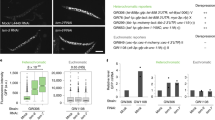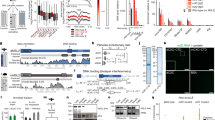Abstract
Heritable inactivation of specific regions of the genome is a widespread, possibly universal phenomenon for gene regulation in eukaryotes. Self-perpetuating, clonally inherited chromatin structure has been proposed as the explanation for such phenomena as position-effect variegation1,2 (PEV) and control of segment determination and differentiation in flies3, X-chromosome inactivation and parental imprinting in mammals4,5, gene silencing by paramutation in maize6 and silencing of the mating-type loci in yeasts7,8. We have now found that the clr4 gene, which is essential for silencing of centromeres9 and the mating-type loci in Schizosaccharomyces pombe8,10, encodes a protein with high homology to the product of Su(var)3-9, a gene affecting PEV in Drosophila1. Like Su(var)3-9p, Clr4p contains SET and chromo domains, motifs found in proteins that modulate chromatin structure. Site-directed mutations in the conserved residues of the chromo domain confirm that it is required for proper silencing and directional switching of the mating type, like SET domain. Surprisingly, RNA differential display experiments demonstrated that clr4+ can mediate transcriptional activation of certain other loci. These results show that clr4 plays a critical role in silencing at mating-type loci and centromeres through the organization of repressive chromatin structure and demonstrate a new, activator function for Clr4p.
This is a preview of subscription content, access via your institution
Access options
Subscribe to this journal
Receive 12 print issues and online access
$209.00 per year
only $17.42 per issue
Buy this article
- Purchase on Springer Link
- Instant access to full article PDF
Prices may be subject to local taxes which are calculated during checkout



Similar content being viewed by others
References
Tschiersch, B. et al. The protein encoded by the Drosophila position-effect variegation suppressor gene Su(var)3-9 combines domains of antagonistic regulators of homeotic gene complexes. EMBO J. 13, 3822–3831 (1994).
Csink, A.K. Henikoff, S. Genetic modification of heterochromatic association and nuclear organization in Drosophila. Nature 381, 529–531 ( 1996).
Chan, C.S., Rastelli, L. Pirrotta, V. A Polycomb response element in the Ubx gene that determines an epigenetically inherited state of repression. EMBO J. 13, 2553–2564 (1994).
Lyon, M.F. et al. Lack of inactivation of a mouse X-linked gene physically separated from the inactivation centre. J. Embryol. Exp. Morphol. 97, 75–85 (1986).
Ainscough, J.F. Koide, T. Tada, M. Barton, S. Surani, M.A. Imprinting of Igf2 and H19 from a 130 kb YAC transgene . Development 124, 3621–3632 (1997).
Hollick, J.B. Patterson, G.I. Coe, E.H., Jr. Cone, K.C. Chandler, V. Allelic interactions heritably alter the activity of a metastable maize pl allele. Genetics 141, 709–719 (1995).
Braunstein, M. Rose, A.B. Holmes, S.G. Allis, C.D. Broach, J.R. Transcriptional silencing in yeast is associated with reduced nucleosome acetylation. Genes Dev. 7, 592–604 (1993).
Klar, A.J.S. Ivanova, A.V. Dalgaard, J.C. Bonaduce M.J. Grewal, S.I.S. Multiple epigenetic events regulate mating-type switching of fission yeast. In: Epigenetics, (eds Chadwick, D.J. and Casdew, G.) 87–103 (Wiley & Sons, Chichester, 1998).
Allshire, R.C. Transcriptional silencing in the fission yeast: a manifestation of higher order chromatin structure and function. in: Epigenetic mechanisms of gene expression, (eds Russo, V.E.A., Martienssen, R.A. & Riggs, A.D.) 443–466 (Cold Spring Harbor Laboratory Press, New York, 1996).
Grewal, S.I. Klar, A.J.S. A recombinationally repressed region between mat2 and mat3 loci shares homology to centromeric repeats and regulates directionality of mating-type switching in fission yeast. Genetics 146, 1221–1238 (1997).
Hoheisel J.D. et al. High resolution cosmid and P1 maps spanning the 14 Mb genome of the fission yeast S. pombe. Cell 73, 103–120 (1993).
Dingwall, C., Laskey R.A. Nuclear targeting sequences--a consensus ? Trends Biochem. Sci. 16, 478–481 (1991).
Singh, P.B. Molecular mechanisms of cellular determination: their relation to chromatin structure and parental imprinting. J. Cell Sci. 107, 2653–2668 (1994).
Platero, J.S. Hartnett, T. Eissenberg, J.C. Functional analysis of the chromo domain of HP1. EMBO J. 14, 3977–3986 (1995).
Messmer, S. Franke, A. Paro, R. Analysis of the functional role of the Polycomb chromo domain in Drosophila melanogaster. Genes Dev. 6, 1241–1254 (1992).
Ball, L.J. et al. Structure of the chromatin binding (chromo) domain from mouse modifier protein 1. EMBO J. 16, 2473–2481 (1997).
Thon, G. Cohen A. Klar, A.J.S. Three additional linkage groups that repress transcription and meiotic recombination in the mating-type region of Schizosaccharomyces pombe. Genetics 138, 29–38 ( 1994).
Thon, G. Klar, A.J.S. Directionality of fission yeast mating-type interconversion is controlled by the location of the donor loci. Genetics 134, 1045–1054 (1993).
Engelke, U., Grabowski, L., Gutz, H., Heim, L. Schmidt, H. Molecular characterization of h- mutants of Schizosaccharomyces pombe. Curr. Genet. 12, 532–542 (1987).
Hardy, C.F., Balderes, D., Shore, D. Dissection of a carboxy-terminal region of the yeast regulatory protein RAP1 with effects on both transcriptional activation and silencing. Mol. Cell. Biol. 12, 1209–1217 (1992).
Liang, P. Pardee A.B. Differential display of eukaryotic messenger RNA by means of the polymerase chain reaction. Science 257, 967–971 (1992).
Allshire, R.C., Nimmo, E.R., Ekwall, K., Javerzat, J.P. Cranston, G. Mutations derepressing silent centromeric domains in fission yeast disrupt chromosome segregation. Genes Dev. 9, 218–233 (1995).
Sawin, K.E. Nurse, P. Identification of fission yeast nuclear markers using random polypeptide fusions with fluorecsent protein. Proc. Natl. Acad. Sci. USA 94, 15146–15151 (1996).
Bryk, M. et al. Transcriptional silencing of Ty1 elements in the RDN1 locus of yeast. Genes Dev. 11, 255–269 ( 1997).
Ekwall, K. et al. Mutations in the fission yeast silencing factors clr4+ and rik1+ disrupt the localisation of the chromo domain protein Swi6p and impair centromere function . J. Cell Sci. 109, 2637–2648 (1996).
Jiang, Y.W. Stillman, D.J. Involvement of the SIN4 global transcriptional regulator in the chromatin structure of Saccharomyces cerevisiae. Mol. Cell. Biol. 12, 4503–4514 (1992).
Nislow, C., Ray, E. Pillus, L. SET1, A yeast member of the trithorax family, functions in transcriptional silencing and diverse cellular processes. Mol. Biol. Cell. 8 2421–2436 (1997).
Moreno, S., Klar, A.J.S. Nurse, P. Molecular genetic analysis of fission yeast Schizosaccharomyces pombe. Methods Enzymol. 194, 795–823 (1991).
Ho, S.N., Hunt, H.D., Horton, R.M., Pullen, J.K. Pease, L.R. Site-directed mutagenesis by overlap extension using the polymerase chain reaction. Gene 77, 51–59 (1989).
Altshul, S.F., Miller, W., Myers, E.W. Lipman, D.J. 1990 Basic local alignment search tool. J. Mol. Biol. 215, 404–410 (1990).
Acknowledgements
We thank members of the Gene Regulation and Chromosome Biology Laboratory for helpful discussions, especially J. Sabl for helpful comments on the manuscript, D. Beach and P. Young for the S. pombe library and A. Arthur for editing the manuscript. This work was sponsored by the National Cancer Institute, DHHS, under contract with ABL.
Author information
Authors and Affiliations
Corresponding author
Rights and permissions
About this article
Cite this article
Ivanova, A., Bonaduce, M., Ivanov, S. et al. The chromo and SET domains of the Clr4 protein are essential for silencing in fission yeast. Nat Genet 19, 192–195 (1998). https://doi.org/10.1038/566
Received:
Accepted:
Issue Date:
DOI: https://doi.org/10.1038/566
This article is cited by
-
Abo1 is required for the H3K9me2 to H3K9me3 transition in heterochromatin
Scientific Reports (2020)
-
Genome-wide analysis of SU(VAR)3-9 distribution in chromosomes of Drosophila melanogaster
Chromosoma (2018)
-
Sound of silence: the properties and functions of repressive Lys methyltransferases
Nature Reviews Molecular Cell Biology (2015)
-
Advancing our understanding of functional genome organisation through studies in the fission yeast
Current Genetics (2011)
-
Roles of the Clr4 methyltransferase complex in nucleation, spreading and maintenance of heterochromatin
Nature Structural & Molecular Biology (2008)



